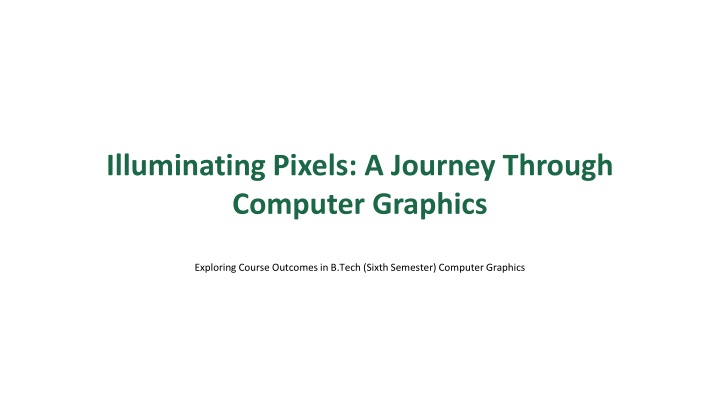
Exploring Computer Graphics: A Journey Through Techniques
Dive into the world of computer graphics in B.Tech's sixth semester course outcomes. Explore line drawing algorithms, transformations, viewing perspectives, illumination, color models, and digital image processing. Learn about the impact of computer graphics in various fields, from gaming to simulations, and understand the technical aspects of image rendering and display technologies.
Download Presentation

Please find below an Image/Link to download the presentation.
The content on the website is provided AS IS for your information and personal use only. It may not be sold, licensed, or shared on other websites without obtaining consent from the author. If you encounter any issues during the download, it is possible that the publisher has removed the file from their server.
You are allowed to download the files provided on this website for personal or commercial use, subject to the condition that they are used lawfully. All files are the property of their respective owners.
The content on the website is provided AS IS for your information and personal use only. It may not be sold, licensed, or shared on other websites without obtaining consent from the author.
E N D
Presentation Transcript
Illuminating Pixels: A Journey Through Computer Graphics Exploring Course Outcomes in B.Tech (Sixth Semester) Computer Graphics
01 Introduction: The World of Computer Graphics Table of Contents 02 Line Drawing Algorithms: The Building Blocks 03 Transformations: Shaping the Virtual World 04 Viewing Transformations: A Window to the Scene 05 Clipping: Refining the View 06 Illumination: Bringing Light to the Scene 07 Color Models: Painting with Pixels 08 Introduction to Digital Image Processing (DIP) 09 Course Outcomes: Achieving Mastery 10 Thank You
1 Introduction: The World of Computer Graphics Exploring the dynamic realm where users engage with visuals, shaping designs and experiences in real-time. From gaming and animation to CAD and simulations, discover the widespread impact of computer graphics. Understanding the fundamental differences in display technologies, impacting image rendering and performance. Calligraphic displays use an electron beam to directlytrace out the lines of an image. Addressing challenges in maintaining image stability and clarity on various display systems.
2 Line Drawing Algorithms: The Building Blocks A foundational algorithm for line generation, stepping throughpixels to approximate a straight line. An efficient algorithm optimizing line drawing by using only integer arithmetic. Definingcircles throughmathematical equations and pixel approximations. Drawing circle, an optimized approach utilizing midpointproperties to enhance circle generation. Extending principles to create curved shapes.
3 Transformations: Shaping the Virtual World Moving objects without changing their shape or size, repositioning elements within the scene. Rotating objects arounda fixed point, alteringorientationin 2D and 3D spaces. Changing the size of objects, magnifying or shrinking elements within the virtual environment. Skewing objects along one axis, creating distorted and stylized effects. Combining multiple transformations to achieve complex manipulations and animations.
4 Viewing Transformations: A Window to the Scene Definingthe global space where all objects reside, establishing a universal reference frame. Mapping the world coordinate system to the viewing plane, simulating the camera's perspective. Displaying 3D objects on a 2D plane. Projecting 3D objects onto a 2D plane, simulating depthand spatial relationships. Understanding how parallel lines converge in perspective projection, addingrealism to scenes.
5 Clipping: Refining the View Determining if a point is inside or outside the viewing window, filteringout invisible elements. Algorithms for clipping lines against the viewing window, ensuringonly visible segments are rendered. An efficient line clipping algorithm using region codes to quickly identify and discard invisible lines. Techniques for clipping polygons against the viewing window, handling complex shapes and intersections. A polygon clipping algorithm processing each edge of the clipping window sequentially.
6 Illumination: Bringing Light to the Scene Simulating light sources and their interactions with surfaces, creating realistic reflections and shadows. Capturing the complex effects of light. Simulating light scattering evenly across a surface, creating a soft and matte appearance. Simulating mirror-like reflections, creating highlights and shiny surfaces. An illumination model interpolating surface normals to create smooth and realistic shading effects.
7 Color Models: Painting with Pixels Representing colors as combinations of red, green, and blue, used extensively in displays and digital imaging. A color model separating luminance and chrominance, optimizing color transmission in television broadcasting. Representing colors as combinations of cyan, magenta, and yellow, used primarily in printing. Representing colors by hue, saturation, and value, providingan intuitive way to select and adjust colors. Selecting colors in the desired proportion.
8 Introduction to Digital Image Processing (DIP) Exploring the core concepts and techniques used to manipulate and enhance digital images. Capturing steps of DIP. Essential elements for processing images, including sensors, processors, and display devices. The first step in image processing. Hardware and software components, including image sensors, processing units, and display devices.
9 Course Outcomes: Achieving Mastery Students grasp the principles, devices, and applications, bridging theory with practical uses. Students gain skills in coding algorithms for generatinglines and shapes. Students can proficientlyapply 2D and 3D transformations, manipulating objects in virtual space. Students implement clipping algorithms for lines and polygons, optimizing scenes for viewing. Students know about the illumination and colors.
10 Thank You We extend our heartfelt gratitude to our professors for their guidance and support throughout this project. We would also like to acknowledge the contributions of our peers and the resources provided by the university. For any questions or further discussion, please feel free to reach out. This presentation was preparedby [Your Names], students of B.Tech (Sixth Semester). Thank you once again for your time and consideration. We hope this presentation has been informative and insightful.
